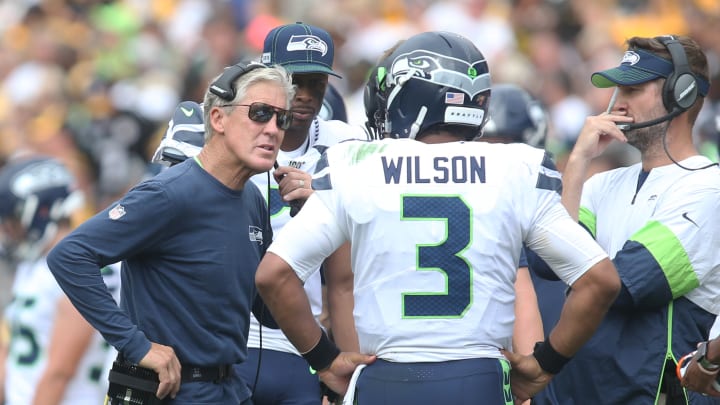5 Questions Seahawks Must Answer This Offseason

With the Chiefs capturing their first Super Bowl title in 50 years following a torrid fourth quarter comeback, the 2019 NFL season has reached its conclusion and an offseason that could shake up the league landscape has officially begun.
Before the confetti had even finished falling in Miami, the Caesars Sportsbook had already revealed betting odds for Super Bowl LV, with the Chiefs favored to repeat with 6-1 odds. Behind them, the Ravens opened with 7-1 odds and the runner-up 49ers opened with 8-1 odds.
As for the Seahawks, who bowed out in the divisional round with a 28-23 loss to the Packers, Russell Wilson’s team opened with 22-1 odds, just behind the Cowboys and Packers.
A critical six weeks awaits for general manager John Schneider as Seattle prepares for free agency and the 2020 NFL Draft. What questions need to be answered in the next few months to give the Seahawks their best chance at winning the Lombardi Trophy next year?
1. Will Jadeveon Clowney and/or Jarran Reed return? And if not, where will the pass rush come from?
As last night re-confirmed, harassing opposing quarterbacks remains a vital component to winning a Super Bowl. The 49ers were in the face of Patrick Mahomes throughout the first three quarters, helping limit the Chiefs to just 10 points in the first 45 minutes of game action. As Kansas City rallied in the fourth quarter, Frank Clark and Chris Jones made their presence felt swatting away passes at the line of scrimmage and sacking Jimmy Garoppolo.
For the Seahawks to make a deeper playoff run in 2020, they’ll have to rectify a pass rush that ranked among the league’s worst in nearly every quantifiable metric. Even after trading for Clowney and signing Ziggy Ansah, they finished next-to-last in sacks, 28th in pressure rate, and 29th in quarterback hits. Rasheem Green led the team with just 4.0 sacks on the year. Such dismal productivity impacts the entire defense and must be corrected.
The Seahawks have some difficult decisions to make, starting with Clowney, who will command north of $20 million per year on the market. After recording just 3.0 sacks last season, is he worth the money? Reed will also be a free agent and endured a rough season with just 2.0 sacks in 10 games after serving a suspension. Depending how his market materializes, he could be elsewhere next season.
If one or both of those players depart, Schneider will need to be aggressive pursuing outside free agents such as Yannick Ngakoue, Matt Judon, and Jones, who are all scheduled to hit the market in March.
Seattle also has three selections in the first two rounds of the draft, providing the ammunition necessary for Schneider to land some pass rushing help. The only downside? This isn’t near as deep of a class for edge rushers as last year and many of the top prospects may already be gone before the Seahawks pick at No. 27 overall.
2. Who will emerge as a third receiving option behind Tyler Lockett and DK Metcalf?
The Seahawks have as good of a one-two receiving punch as you’ll find in the NFC with Lockett and Metcalf coming off a 2019 season in which they combined for nearly 2,000 receiving yards and 15 touchdowns. Lockett took the challenge of replacing Doug Baldwin as the team’s No. 1 receiver and ran with it, eclipsing the 1,000-yard mark for the first time in his career. Just turning 22 in December, Metcalf has barely scratched the surface of his potential after posting 900 receiving yards as a rookie and his tireless work ethic should ensure he will be even better next year.
But there’s a major drop off in production behind Lockett and Metcalf on the depth chart. David Moore didn’t make the third year jump the Seahawks hoped he would, producing less receiving yardage and touchdowns than 2018, while no other receiver surpassed 250 yards on the season. Tight end Will Dissly scored four touchdowns in five games before being lost for the rest of the season with a ruptured Achilles tendon. As his replacement, Jacob Hollister wound up finishing third on the team with 349 receiving yards in 11 games.
Even with Dissly on the mend, finding a reliable third receiving option should be prioritized by Seattle this offseason. Schneider should have no issues accomplishing that task in April, as this year’s draft class is loaded at receiver and talent that typically comes off the board in the first round should be available on day two. Among potential fits, Baylor’s Denzel Mims, Arizona State’s Brandon Aiyuk, and Florida’s Van Jefferson could all be available in the second or third round to add to Wilson's arsenal.
3. With the safety position set, is Tre Flowers the right fit as Seattle’s second cornerback?
After acquiring Quandre Diggs from the Lions in a midseason trade, the Seahawks should be good to go at the safety position coupling him with Bradley McDougald and second-year defender Marquise Blair. But while Shaquill Griffin looks poised to receive a long-term extension after a breakout 2019 season, the jury is still out on whether or not Flowers can make a similar jump entering his third NFL season.
For most of 2019, as showcased in the above film breakdown, Flowers showed tangible progress compared to his rookie season. He held opposing quarterbacks to a 72.5 passer rating, tied Diggs for the team lead with three interceptions, and produced more tackles and passes defensed. In some ways, he had a better season than Griffin statistically.
However, two poor playoff performances cast some doubt about Flowers' viability as a long-term starter.
Seattle shouldn’t give up on Flowers yet, as he’s still only played two years at cornerback after being a safety at Oklahoma State and has showed promise. But the organization can’t afford to go into next season without at least adding some capable competition to push him and this draft features several tall, lengthy cornerbacks that fit what coach Pete Carroll looks for at the position, including Nebraska’s Lamar Jackson, Virginia’s Bryce Hall, and Oklahoma State’s A.J. Green.
4. As three starters prepare to hit free agency, what will the offensive line look like compared to 2019?
Continuity has evaded the Seahawks along the offensive line for most of Carroll’s tenure, but refreshingly, the team entered the 2019 season with four returning starters in the trenches. But while Carroll has made it clear he hopes to keep most of the current line together again in 2020, this offseason is setting up to be one of substantial change for Seattle’s front line.
After declining his fifth-year option, starting right tackle Germain Ifedi will test free agency, while key reserve George Fant and left guard Mike Iupati will also be free to sign with any other team. Losing all three players is a strong possibility, especially with other line-needy teams willing to overpay for young, capable tackles such as Ifedi and Fant. Center Justin Britt’s future could also be in limbo coming off a torn ACL, as his cap hit eclipses $11 million in 2020.
It remains to be seen what Seattle will do with Britt, but most likely, the team will open the season with a new left guard and a new right tackle at minimum. Phil Haynes will be the favorite to supplant Iupati in the lineup, while Jamarco Jones would be the in-house candidate to take over at right tackle if Ifedi and Fant both depart. A strong draft class at tackle and center creates some flexibility for the Seahawks as well.
5. Based on 2019 results, will the Seahawks shift away from their base-heavy tendencies on defense?
Away from the plethora of decisions Schneider and Seattle’s front office must make over the next two months, Carroll and his coaching staff have to figure out what they want to do from a schematic standpoint defensively in 2020. Last season, taking advantage of great talent and depth at linebacker, the Seahawks deployed their base 4-3 defense on 52 percent of defensive snaps. No other team played base defense more than 30 percent of the time.
“We’ll have to wait and see on that one,” Carroll said when asked if Seattle would play as much base in 2020. “I did this in San Francisco in like 1997 or something like that, after the ‘96 Super Bowl. We played a ton of base versus 11 that year. We played great defense that year. The next year we adjusted a little bit, and it was ok the next year too. Just trying to stay ahead of them and work things out.”
Even if Carroll has an inkling to use a similar strategy next year, which would seem unwise given the mediocre results this past season, personnel changes may prevent him from doing so. Mychal Kendricks suffered a torn ACL in Week 17 and is an unrestricted free agent. While Cody Barton proved capable as a SAM linebacker in his absence and has a bright future, he’s not the same threat as a blitzer and struggled holding the edge as a run defender in four starts.
Going into the offseason, the Seahawks must figure out what direction they want to go at nickel cornerback, which could determine their schematic course of action next season. Ugo Amadi played well in a playoff win against the Eagles, but his lack of experience showed against the Packers the following week. Just as with Flowers, it’d be a prudent move for Seattle to either draft or acquire competition for Amadi heading into offseason activities.
